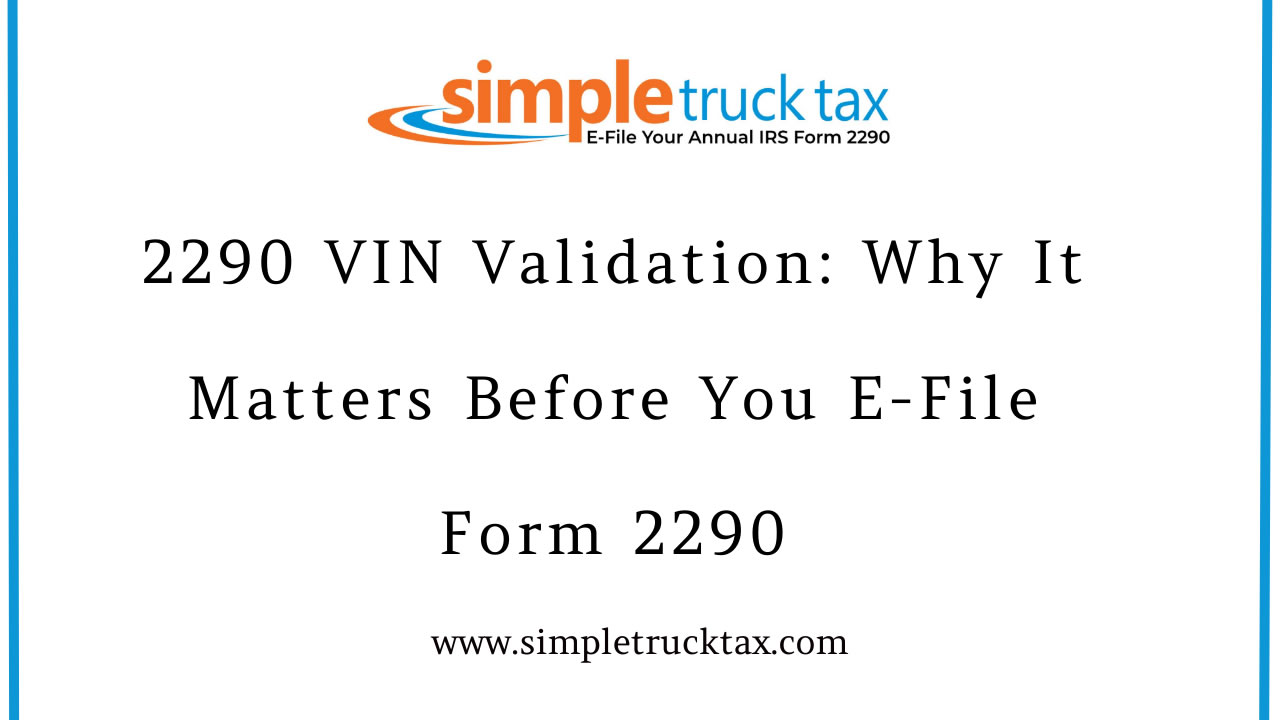
2290 VIN Validation: Why It Matters Before You E-File Form 2290
2290 VIN Validation: Why It Matters Before You E-File Form 2290
Form 2290 Heavy Vehicle Use Tax (HVUT) filings are often rejected by the IRS most due to incorrect or invalid VINs. One small typo, such as writing "O" instead of "0," can lead to major issues, making VIN validation crucial for 2290. We will show you in this guide what VIN validation is all about, why it's important, and how you can validate your VIN quickly before e-filing Form 2290 over the Internet.
What Is VIN Validation?
VIN Validation is verifying that your Vehicle Identification Number (VIN) is legitimate, formatted correctly, and matches vehicle registration details before filing your Form 2290. Every heavy vehicle (55,000 pounds and above) bears a unique 17-character VIN assigned by the manufacturer. This code includes information like:
- Manufacturer of the vehicle
- Model and year
- Vehicle type
- Assembly plant and serial number
When applying your Form 2290 electronically, the IRS uses this code as a means of tying your payment to your particular vehicle, so it must be correct to the 100% exactness.
Why VIN Validation Is Important to Filed Form 2290
Mistakes in VIN filing lead to:
- Rejection by IRS of Form 2290
- Schedule 1 (Proof of Payment) becomes invalid; hence, the truck cannot be registered
- Hold-ups at renewal or registration with DMV
Extra filing charges in case of re-filing or filing a VIN correction Extra filing charges in case of re-filing or filing a VIN correction.
Validating your VIN ahead of filing would save you from incurring the costs associated with these long-lasting and frustrating mistakes.
Common VIN Mistakes Truckers Make
Most errors regarding the IRS rejecting a VIN have to do with typing errors on a piece of paper. Here are some of the following:
- Using O (letter) instead of 0 (zero)
- Using I (letter) instead of 1 (number)
- A VIN less than or exceeding 17 characters
- Using lower case letters or spaces
- Typing in a VIN for a different vehicle in your fleet
Validate Your VIN Before Filing Form 2290
Follow these steps to check that your VIN is indeed valid:
Find the VIN
You can locate your VIN on your vehicle title or registration. You may also find your VIN on your dashboard, which is at the driver's side near the windshield.
Check the Format
It should measure exactly 17 characters in length, comprising numbers and capital letters, but never the letters I, O, or Q.
Use a Validation Tool for VINs
A few 2290 e-file providers offer such a service — the free feature that enables one to check for invalid characters and confirm that the VIN conforms to the IRS-accepted format.
Double Check and Submit
Check your Form 2290 once again before e-filing so you can determine if the VIN inputted is correct.
What If You Filed with the Wrong VIN?
If you just filed your Form 2290 and then realized that you made a mistake by inputting the wrong VIN, do not panic.
You can do that very easily by submitting a 2290 VIN Correction form online.
This e-filing is extremely simple since it includes only the correction of the VIN.
Newly corrected Schedule 1s will be waiting for you after approval from the IRS.
No refiling or paying of HVUT for that vehicle.
Your original and corrected Schedule 1 should always be kept for records.
Example of a Correct VIN
This is a valid VIN:
1FDXF46S12EC58312
Each of these characters tells something about your truck's manufacturer, model, and year-all of which must enter into your 2290 correctly.
Validate Your VIN Before You File
Before e-filing Form 2290, be sure that your VIN is validated so that the IRS will not raise any delays or rejections.
The system, at [Your Company Name], automatically checks your VIN format and sends you alerts if something goes wrong, saving you time from building all these complaints. Related Resources
How to File Form 2290 Online
2290 VIN Correction Filing Guide
IRS 2290 Vehicle Identification Number Guidelines (irs.gov)
A small VIN error can bring enormous headaches, but you can avoid them altogether by validating in such a quick manner through 2290 VIN. Always verify your VIN before filing Form 2290, and if needed, file a correction immediately for accurate IRS recordkeeping and safe trucks on the roads.